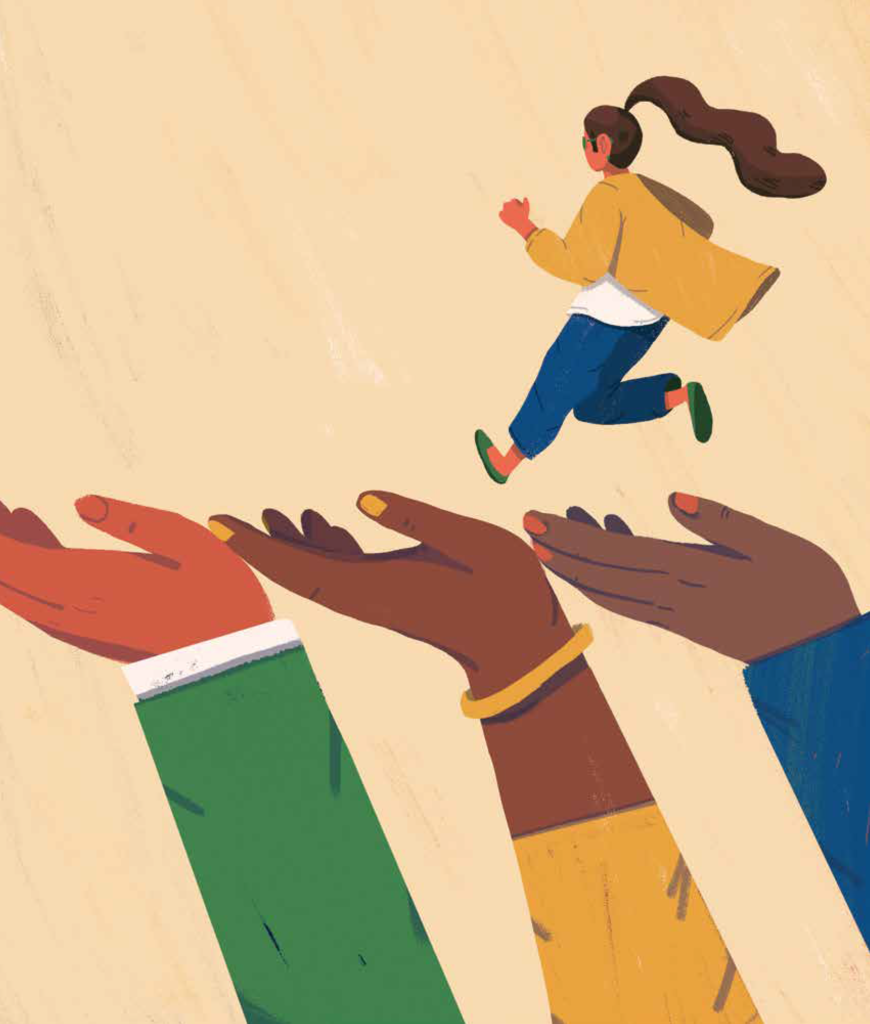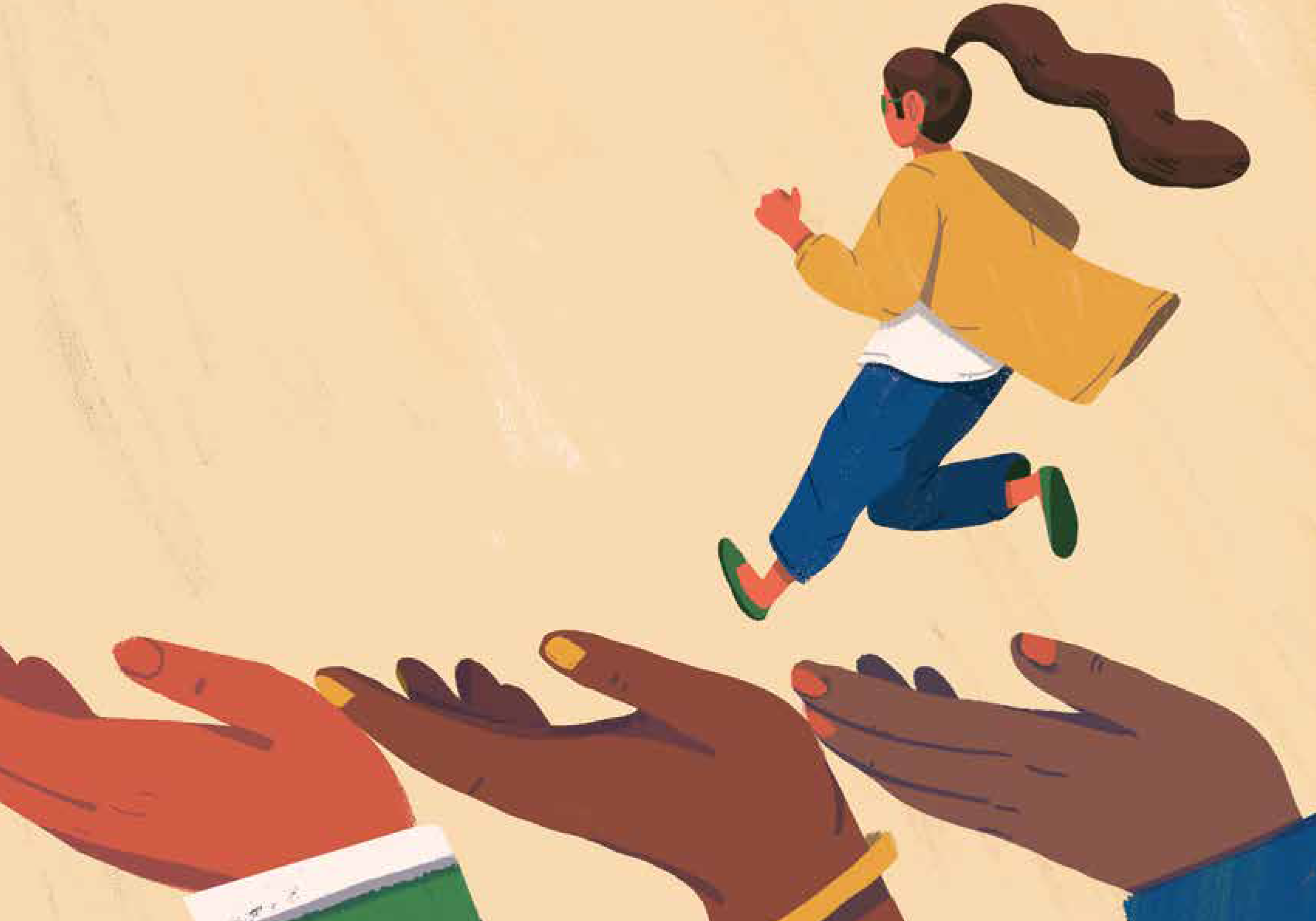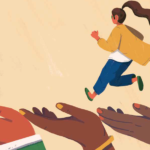The growing influence of community organizations and individuals who are working hard to boost inclusion in a still all-too-white profession
 Illustration by Anja Javelona
Illustration by Anja Javelona
[su_dropcap style=”simple” size=”10″]E[/su_dropcap]very now and then, tremors of controversy ripple through Canadian media, leaving journalists to pick up the pieces. Some leave a mark.
For Ishani Nath, this happened on her first day back in the office at Flare magazine, following the publication of a now infamous op-ed in the Spring 2017 issue of Write Magazine. Every morning, Nath and her colleagues would start their day with a friendly catch-up—this particular morning, each team member’s head was poking out above their cubicle walls in shared disbelief. Big names at Rogers Media, such as Ken Whyte (a former editor-in-chief of Maclean’s) and Steve Maich (then senior vice president of digital content and publishing), were involved in calls to fund an “appropriation prize,” an idea harvested from the now ex-editor of the Writer’s Union of Canada’s quarterly publication.
In a published piece, Hal Niedzviecki urged writers to “imagine other peoples, other cultures, other identities,” advocating that reader-approved attempts at this be rewarded. Condemnations of his op-ed were stoked by its appearance in an issue of Write focused on Indigenous writers. Before Nath went back to work, she received text messages from friends at various Rogers Media publications, informing her of the tension fomenting in the building. The team at Flare, says Nath, had been making an effort that year to be more inclusive, reaching out to racialized writers to consult on how they could increase representation after informal internal discussions made them realize they needed to. After seeing Whyte and Maich’s responses to Niedzviecki’s piece, offering up hundreds of dollars to fund an actual appropriation prize, the team was worried that their efforts had been undermined.
They knew they had to respond quickly, and as one of the only women of colour on staff at the time, Nath felt like she had to be the one to do it. Following the team’s discussions, her article “#AppropriationPrize: How I Feel as a WOC at Rogers Media Right Now” was up on Flare’s website the next day.
The piece was both a documentation of the energy in the magazine’s office space (“[it] felt less welcoming than before,” she wrote) and a reflection on how she felt in response (“a responsibility to stand up for the people who are not in the room”).
“I think that [piece] really set a career trajectory of sorts for me,” says Nath now, thinking back on that moment. “It was really early on in my career…but it kind of shattered that illusion that everything is okay. And I’m really privileged to have even thought that things were okay.”
Moving forward, she grappled with the intersection of her identity and her work. She questioned how much of herself she could put in her stories and how to deal with the ensuing emotional burden. It wasn’t until later that year when Nath attended the first informal meeting of a collective for South Asian women in the creative industries that she could finally breathe a sigh of relief.
[su_dropcap style=”simple” size=”10″]G[/su_dropcap]rassroots collectives are instrumental spaces for journalists of colour to network, seek help, and most importantly, find community in shared experiences. These efforts have grown and flourished as racialized journalists organize to build systems of support under a backdrop of persistently poor representation and unstable working environments. They do so in a journalism industry designed to consistently reinforce the voices of the mainstream—“and the mainstream has no interest in sharing power,” says Vinita Srivastava, director of journalism innovation and senior editor of culture, society, and critical race at The Conversation Canada. While the industry as a whole hasn’t improved much on providing racialized journalists with adequate support, grassroots organizations, often borne of online solidarity, are taking shape.
Before the advent of organized networks, a handful of publications filled the gap—highlighting voices from communities absent from mainstream media in Canada. Newspapers such as Share—founded more than 40 years ago to cover stories of interest to Black and Caribbean readers in the GTA—function distinctly from many other ethnic community newspapers, which service mostly diasporic communities concerned primarily with coverage from home countries. ByBlacks, a digital magazine that won the National Ethnic Press & Media Council of Canada’s 2018 awards for best online magazine, has been covering topics from Black Canadian history to local business leadership since 2013. Established in the early 1990s, Rungh (meaning “colour” in many languages, including Urdu, Punjabi, and Hindi), was one of the first publications that gave South Asians in Canada a space to express themselves, running as both a society and quarterly print magazine based out of British Columbia. After almost two decades of lying dormant and working to rebrand, it relaunched in 2017 as a cultural web platform focusing on BIPOC (Black Indigenous People of Colour) artists. The Ethnic Aisle, an online magazine, came onto the scene in 2011 and ran until 2018, serving as an outlet for writers from diverse communities to explore stories through lenses of race and ethnicity. During this time, it executed a variety of events with enthusiastic turnouts.
In her piece “Secret Solidarity” in the Spring 2017 issue of the Ryerson Review Journalism, Farnia Fekri chronicles the organic mentorship pathways sprouting up in Canadian media to replace the few formal efforts that had petered out over the prior century.
Now, in the wake of historic flashpoints that have sparked conversations about the need for systemic change—media specific calls to action in the 2015 Truth and Reconciliation Commission report; the prime minister’s blackface scandal during the 2019 federal election campaign; and the momentum from support through social media conversations—working journalists are speaking out about a lack of inclusion and responsible journalism. In the absence of any substantive managerial efforts to address an age-old issue, journalists of colour are banding together through a variety of initiatives to create programs, cement organizational alliances, and create opportunities to push for change.
[su_dropcap style=”simple” size=”10″]W[/su_dropcap]hen Nikkjit Gill walked into her first day as an undergraduate student at the Ryerson School of Journalism in 2007, one of the first things she noticed was that very few people looked like her. Hailing from Mississauga, about an hour west of Toronto, she grew up in diverse classrooms, surrounded by diverse neighbourhoods, so she struggled to find her place in a program that lacked diverse representation.
Gill’s experience mirrors that of other journalists of colour across Canada, whether they are just starting out in journalism school or the newsroom. Since 2016, Gill has worked as the managing editor at Post City Magazines, where she says she’s one of only three people of colour on a team of 25, and the only racialized person on the editorial team. As a manager who’s a part of the hiring process, she sees firsthand why the applicant pool isn’t diversifying.
“If we can just be more inclusive in getting people to pursue this industry, I would have more to choose from when I’m reading those resumes,” says Gill.
In 2018, Gill joined forces with her friends and fellow Ryerson journalism graduates, Arti Patel and Roohi Sahajpal, to launch Didihood, with Gill and Patel leading a chapter in Toronto while Sahajpal took charge in Vancouver. Together, they set out to create a network of sisters—or “didis” in Hindi—for South Asian women in the creative industries, a space to connect with one another and foster professional growth.
[su_quote cite=”Denise Balkissoon”][Newsroom leaders] should consider it a personal success or a personal failing if, in their very long careers, they have or have not addressed this problem [of lack of representation] [/su_quote]
“If you want to see more people that look like you in creative industries like journalism, and everything related to it, you have to encourage those people to pursue those jobs in the first place,” says Gill. “So, a big thing for us is being able to mentor them. None of us had mentors that we really connected with when we were growing up.”
On a cold evening in mid-December 2019, Didihood’s Toronto chapter hosted a small networking night to celebrate the end of the first round of a newly minted mentorship program, for which they had vetted applications to connect mentors and mentees. The program is set up so that paired duos meet up regularly—preferably once a month—for the more experienced professional to support the emerging one with a number of practical and other skills: resumes, how to kill an interview, how to navigate the industry, how to network, and so on. A smiling Gill and Patel eagerly anticipated their guests’ arrival to the intimate space at Alchemysts Inc., a public relations and communication agency in downtown Toronto. In a few minutes, the quaint room would be bustling with the collective’s first cohort, a network of sisters about two dozen strong.
Later that night, Patel, features and lifestyle news editor at Global News, explained how she and Gill had begun to brainstorm ideas for a collective back when they were journalism students, but it wasn’t until Patel attended a workshop focusing on women’s entrepreneurship and creativity roughly six years later that she was inspired to get going.
When she got home that night, she immediately opened her WhatsApp group chat with Gill and Sahajpal, an employment counsellor in Vancouver, and sent a simple message: “Hey, we’re starting this like, now.”
Her first move was to take to social media, tweeting a call out to South Asian women in journalism to gauge interest in a collective aiming to create a space for Brown women in the industry. The response, she says, was immediate, as her Twitter flooded with notifications. The next step was to arrange a meetup with the women who had replied in order to find out what exactly they would want from the organization. According to Patel, there were three prominent needs: a place to network, to socialize, and the opportunity to mentor young South Asian women coming into the industry.
Nath was one of the dozens of women who had responded to Patel on Twitter and attended that first brainstorming meetup. On that day, donning a shirt designed by Indo-Canadian artist Babbu the Painter, she nervously entered the Love Child Social House in Toronto to meet with a group of women who, until this point, she only knew from Twitter. Seated on chairs and couches arranged rectangularly in a little nook at the back end of the space, they all quickly grew comfortable and spent the night indulging in their shared experience and struggles.
“It felt like the start of something really exciting,” shares Nath. She recalls feeling emotional listening to women at the meeting share workplace frustrations that almost mimicked her own. There was a “lightbulb moment,” she recounts, when they agreed that if they had had someone to ask for advice or someone to share their experiences with, navigating the industry as South Asian women would have been a lot easier. She applied to be a mentor for when Didihood launched its mentorship program in the fall of 2019, a decision her mentee, second-year journalism student and communities editor at The Eyeopener Dhriti Gupta, is very grateful for. Gupta feels that a common understanding helped her share problems without the need to start explaining herself from square one, such as when she asked Nath for advice on whether or not she should pursue a master’s degree after completing her undergraduate, a path that many young South Asian students are expected to pursue. “I feel like if I was talking to someone who maybe didn’t have the same cultural upbringing as me they’d be like ‘Oh, why do your parents care about that if that’s not relevant for your program?’,” says Gupta. “I didn’t have to explain that to her.”
“We’re all trying to figure out this sense of inclusivity in journalism on our own right now, there is no guidebook,” says Gill. “I think people are really making a big effort to create these new spaces and to create these mentorship opportunities.”
[su_dropcap style=”simple” size=”10″]A[/su_dropcap]nita Li, a media consultant, journalism professor, and founder and editor-in-chief of The Other Wave, initially left Canadian media because she was unable to cover issues that were important to her—such as diversity, inclusion, and race. After spending a few years working at a small handful of media startups in the United States, she came back to Canada in 2017. Having observed an openness to race-related pitches from editors in the U.S., she was determined to “challenge the status quo” by addressing issues regarding underrepresentation in Canadian newsrooms, and also to facilitate ways for journalists of colour to foster connections.
In 2018, she met Sadiya Ansari, who had already been working on ways for journalists of colour in the industry to connect. Ansari, a Toronto-based writer, editor, and professor of journalism at Centennial College, has been through more than her fair share of uncomfortable or inappropriate workplace experiences, recounting many points in her career where she—and a handful of others—were expected to serve on diversity committees. She says that the idea of the media being a “closed club” inspired her to start a new space for BIPOC journalists. Why try and squeeze herself into an exclusionary cultural space?
Together, Li and Ansari co-founded Canadian Journalists of Colour. In October 2018, they launched CJOC via a private Facebook group and Slack channel. Within a year, the group had almost 600 members—including journalists, journalism students, and professors of colour—networking, sharing opportunities, and providing support.
This new space proved invaluable for practicing journalists in mainstream Canadian newsrooms. Two national newsroom workers, who spoke to the RRJ under condition of anonymity to avoid workplace repercussions, described how they felt in the days after the first photos of the prime minister in blackface were published. Between white colleagues across the room cracking jokes that belittled the racist underpinnings of the scandal and seeking consolation surrounding what their own dabbling in “blackface costumes” says about them, both felt deeply frustrated. “I had never felt so visible and invisible at the same time,” says one of the journalists. “I felt like nobody was seeing me, but I was very aware of my skin colour in that moment.” They both turned to the respite of the CJOC Facebook group—somewhere they felt like they were not alone in facing these experiences. Hearing other journalists of colour recount similar challenges helped, and being a part of the group provided a strong sense of community “because there’s just the notion or the idea that you’re not alone,” says the other.
These spaces are important for journalists of colour, as many continue to face barriers in discussing race and representation issues in their newsrooms.
The most detailed study of representation in newsrooms on a national scale was done back in 2004 by professor emeritus at the Ryerson School of Journalism, John Miller, and researcher Caron Court. After conducting a survey on the demographic makeup of Canadian newsrooms and calculating results based off of the answers of those who responded, they found that only 3.4 percent of journalists in these newsrooms were journalists of colour. Because this survey and others that followed it, such as one by Vicky Mochama for Canadaland in 2016, relied on voluntary participation, editors of many publications did not respond to the surveys.
Newsroom leaders should be the ones held accountable for this lack of representation, says Denise Balkissoon, executive editor at Chatelaine. Balkissoon says she’s been asked the same questions about ethnic diversity in the newsroom by quite a few student journalists over her 20 years in the industry. She believes that these questions should instead be posed to those in hiring positions. “They should consider it a personal success or a personal failing if in their very long careers they have or have not addressed this problem.”
Management teams at prominent Canadian newsrooms like to hold on to their right to hire and exercise control, explains Brian Gibson, president of Unifor Local 2000. Gibson’s local represents over 700 media workers in British Columbia, including those at papers like The Vancouver Sun and The Province. He says that all the union can do in order to ensure that employers look at their hiring process through a “lens of diversity” and keep representation in mind is to engage management teams in relevant conversations and remind them to visualize the communities they represent. However, Gibson says that Unifor Local 2000 works to take action when the jobs of the workers they represent are put at risk.
In early 2017, when Postmedia announced plans to lay off 54 employees at The Vancouver Sun and The Province, the union intervened to negotiate a deal, involving taking a pay cut themselves, that ended up saving 21 jobs. A driving factor behind their bargaining push was the knowledge that junior employees—representing the most diverse cohort in those newsrooms—would be the first to go.
Unifor Local 2000 was the first of two unions to endorse seven calls to action (CTAs) co-released in late January 2020 by CJOC and the Canadian Association of Black Journalists (CABJ). On March 2, CWA Canada, the country’s only all-media union, also endorsed the CTAs to increase accountability and diversity in Canadian media, including pushes to hire, retain, and promote journalists of colour to management positions and regularly self-report newsroom demographics.
[su_dropcap style=”simple” size=”10″]I[/su_dropcap]n a study that delves into the past 21 years of columnist demographics at The Globe and Mail, the Toronto Star, and the National Post, Ryerson School of Journalism faculty members Asmaa Malik, associate professor, Sonya Fatah, assistant professor and RRJ instructor, and researcher Davide Mastracci, found that in that time only three Black men and zero Black women worked as recurring columnists at these publications, with no Indigenous columnists to be found. In as-of-yet unpublished results, the team did find that South Asian journalists were “adequately” represented in a comparison of total columnists to general population census data. “Unfortunately, we cannot get a clear picture of Canadian news organizations without their cooperation,” Malik told the RRJ by email. “But from our columnists’ study, we have gleaned that while newsrooms still have a long way to go to better represent Canada, people who self-identify as South Asian make up a larger part of the population of BIPOC journalists in general.”
[su_quote cite=”Lela Savi´”]I really think that you can’t have diversity and inclusion if you don’t have an anti-racist perspective [/su_quote]
While Didihood is trying to do its part for South Asian women in the industry, Gill explains that they didn’t feel they could be facilitators of a space designed to serve other underrepresented communities. She feels that it would be unfair for her to give her input on the challenges that Black and Indigenous women face coming into the industry given her own experiences. “If we made it a space for something beyond what we actually represent, we would be taking up that space for somebody who’s actually from that community who could create that space and probably do a way better job of it,” she says. Didihood’s official launch came one month after the CABJ, originally founded in 1996, announced its relaunch in March 2018, after lying dormant for almost a decade.
Lela Savić, head of CJOC’s Quebec chapter and journalist at Journal Métro, feels a professional responsibility to ensure that she herself does not take a spot that would be better suited to someone from a different community, echoing Gill’s sentiments. She says that she has had conversations discussing frustrations about seeing white reporters in their newsrooms being assigned to beats on Indigenous people or diversity, despite workplace policies on inclusion being in place.
Unfortunately, policies being implemented to promote diversity in newsrooms does not mean that the industry is suddenly welcoming towards journalists of colour. “I really think that you can’t have diversity and inclusion if you don’t have an anti-racist perspective,” says Savić.
In June 2018, Poynter created and released “A survival kit for journalists of color.” In the accompanying piece, Seema Yasmin detailed the internal and external struggles that racialized journalists constantly face: wanting to leave their jobs because their voices are never heard, but feeling as though they would let their communities down if they did so.
Through organizations and collectives such as Didihood, CJOC, and Media Girlfriends—an organization that emerged from a podcast series by CBC’s Fresh Air host Nana aba Duncan, now offering student scholarships to women and non-binary people who want to get into media, technology, journalism, or communications fields—journalists from underrepresented communities can engage with each other and alleviate the pressures of the struggles that they face.
“Things are changing, you know, I believe that things are changing,” says Srivastava. “There are some people in most organizations that want things to change and then there are people in those organizations that are changing things.”
Emerging journalists of colour are paving paths for themselves in the industry, says Li. She adds that some young journalists have not grown up with the same level of internalized racism as the generation before them, a shift that may help them to be bolder and more courageous with less internal limitations, “which is amazing to see, and shows that we are making the right kind of change,” she expresses.
Duncan encourages young journalists of colour to “keep striving for excellence.”
She says that racialized journalists often get clues to doubt themselves. “I say eff that noise,” she says. “You belong, man. Don’t ever feel like you don’t belong.”
[su_dropcap style=”simple” size=”10″]A[/su_dropcap] few days before Didihood’s mentorship wrap-up and networking event, Gill was sitting with her father as they discussed how the program had gone so far. She told him about all of the effort that she and Patel had put into organizing these mentorship opportunities for young “didis” in the collective’s Toronto chapter, to which he replied: “You put so much work into this mentorship program, did anybody ever do this for you?
Her response to her father was simple.
“No, that’s why I’m doing it!”



